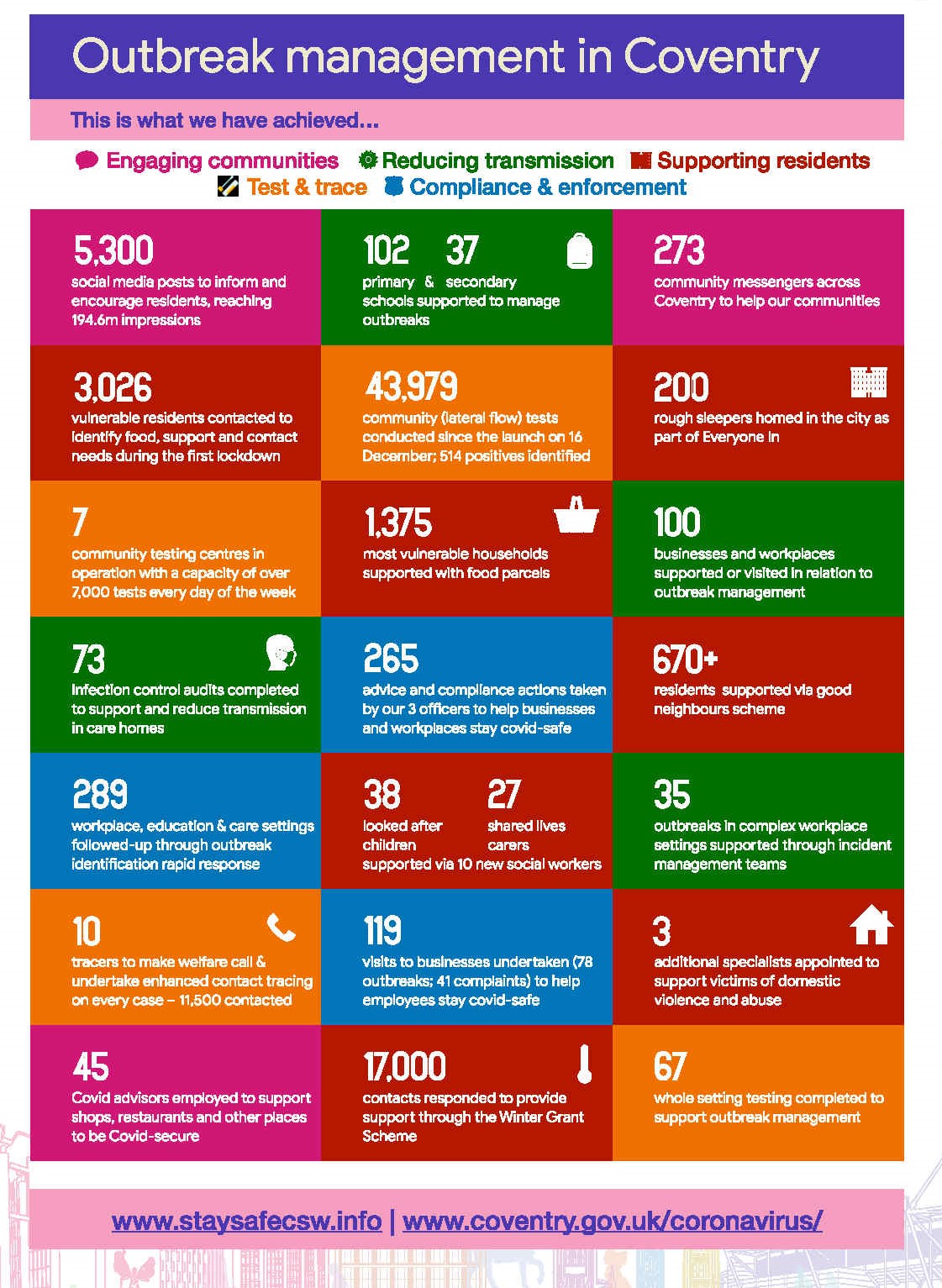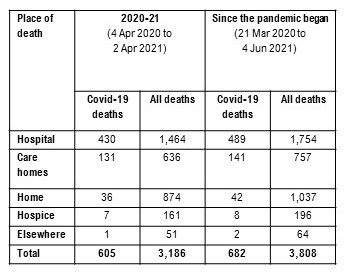Reducing health inequalities
Life expectancy
Healthy life expectancy
Healthy life expectancy indicates the average number of years a person could expect to live in good health. Coventry’s healthy life expectancy at birth for males (61.9 years) and females (64.2 years) are both similar to the figures for the West Midlands Region and for England. Trend-wise, England’s healthy life expectancy figures for both males and females have been stable from 2009-11 to 2017-19. While male figures have tended to perform worse than England average between 2009-11 and 2012-14, it has caught up since 2013-15 and has remained statistically similar to England average.
Direct impact of Covid-19
Between 1 April 2020 and 31 March 2021, Coventry experienced 23,205 cases of Coventry. Women were more badly affected than men – with 46.9% of the city’s Covid-19 cases were amongst men, and 53.1% amongst women.
Coventry North East was the worst hit of the three parliamentary constituency areas of the city. The Wards with the highest number of cases was Foleshill (1,864 cases) followed by Lower Stoke (1,731) and St Michael’s (1,614).The Wards with the lowest number of cases was Earlsdon (774 cases) followed by Whoberley (876) and Woodlands (916).
Accounting for the different population in the wards, the ward with the highest rate of Covid-19 infections was Holbrook, followed by Foleshill, and Longford; and the lowest, St Michael’s.
In terms of ethnicity, of the 23,205 cases:
• 4,020 are of people of an Asian ethnicity (17.3%);
• 1,446 Black (6.2%);
• 611 Mixed (2.6%);
• 754 Other (3.2%);
• 1,310 White Other (5.6%);
• 10,490 White British (45.2%);
• 4,574 Unknown (19.7%).
Hospitalisations due to Covid-19
Up until 30 June 2021, 2,807 patients were admitted to University Hospitals Coventry and Warwickshire (UHCW) due to Covid-19. This includes 2,527 admissions between 1 April 2020 and 31 March 2021. At the peak of the winter wave in January 2021, 286 beds at UHCW were occupied by Covid-19 patients, and 43 Covid-19 patients were in mechanical ventilation beds; placing obvious and severe pressures on the hospital’s capacity to respond to other illnesses, accidents, and emergencies.
Deaths due to or involving Covid-19
The following table sets out the number of people in Coventry who died due to or involving Covid-19. That is, a person with Covid-19 recorded as a cause of death on their death certificate as certified by their doctor.
In 2020/21, Covid-19 accounted for nearly one-fifths of all Coventry deaths. Over 90% of Covid-19 deaths are “due to” (caused by) Covid-19; and fewer than 10% are “involving” Covid-19 (where Covid-19 is a contributing factor to the death). Separate data from the Care Quality Commission suggests 200 care home residents in Coventry died due to Covid-19 – this is more than the figure in the table above, because the ONS data shows place of death (some care home residents will have died elsewhere, in hospital, for example.)
To put Covid-19 deaths in perspective with major events in Coventry’s history, the official death toll during the Coventry Blitz on 14-15 November 1940 was 554 people; and around 1,250 people were killed in Coventry by air raids between June 1940 and August 1942.
Wider health impacts of Covid-19
Good health and wellbeing are influenced by multiple factors, such as employment status, living environment, personal relationships, and having a voice in decisions that affect you. During the pandemic, many facets of life that were key to health and wellbeing, also known as the wider determinants of health, were impacted. Nationally, Public Health England reports that, during the pandemic:
• half of the survey responses of people who had a worsening health condition in the preceding seven days did not seek advice for their condition. The most common reason given was to ‘avoid putting pressure on the NHS’; • • self-reported mental health and wellbeing has worsened;
• increase in people were helping others more than before; and
• increase in snacking, cooking from scratch, eating healthy meals, and eating with family
• increase in people attempting to quit smoking has increased.
Together, these will have a mixed impact on overall health and wellbeing.
Locally, draft, preliminary findings from the Council’s latest household survey, conducted in February 2021 found:
• just under three-quarters of a representative sample of Coventry residents said their health was good, a decrease from 2018;
• fewer residents reported smoking cigarettes or e-cigarettes than in 2018;
• similar number of residents reported eating the recommended level of fruit and vegetables;
• fewer residents reported eating takeaways; and
• an increase in residents consuming alcohol at least once a week.
Residents were also asked about the impact of the pandemic on various factors. Fewer residents were worried about their relationships with people they live with, their job, connectedness to the local community; but there were greater concerns about the impact on their finances, physical and mental wellbeing, and lifestyles.
The Council worked with Warwickshire on a joint Coventry and Warwickshire Covid-19 health impact assessment. The assessment sought to identify key factors that may affect the population’s health and wellbeing as a direct result of Covid-19.
Key findings include:
• an integrated recovery: the analysis shows that health and wellbeing has been deeply impacted by changes across the wider determinants of health; health behaviours and lifestyles; the health and care system; and the places and communities we live in. The implication is that recovery must be connected across all four parts to have the biggest chance of success; and
• the double impact – the harm from Covid-19 itself has been unequally distributed across the population. The analysis shows that the wider impacts from the pandemic and lockdown will fall more heavily on those same communities most directly affected by the disease – with the burden falling on communities who are living in areas of greater deprivation, with less ability to mitigate against the disease.
Local picture for mental wellbeing
The Coventry and Warwickshire Mental Health Needs Assessment survey results have revealed:
• inequalities regarding access to services for people with protected characteristics (women, ethnic minorities, LGBT+ people); people at financial disadvantage (including digital disadvantage); and people living with or facing multiple complex needs (such as homelessness, substance misuse, offending behaviour, mental ill-health, domestic abuse);
• service disruptions and an increase in waiting times across a wide range of health and social care services, including mental health services;
• struggles with isolation; the blanket coverage of the pandemic in social media; and digital exclusion from the shift to digital-only services.
Additionally, the Coventry Safe Haven survey suggest that people experiencing mental ill health have experienced greater levels of social isolation, contributing to an increase in depression, self-harm, and suicidal thoughts. Service users have reported struggling with the lack of physical presence and contact; changing the dynamics of their relationships.
Vaccinating Coventry
The coronavirus (Covid-19) vaccines are safe and effective. They are our best defence against the virus and gives the best protection against the disease. On 8 December 2020, Coventry’s University Hospitals Coventry and Warwickshire (UHCW) was the first place in the world where a patient, Margaret Keenan, received a coronavirus vaccination as part of a vaccination programme outside of a clinical trial.
Anyone who gets Covid-19 can become seriously ill or have long-term effects (long Covid). Research has shown that the vaccines significantly reduce the risk of getting seriously ill or dying from Covid-19; reduce the risk of getting symptoms of Covid-19; and help reduce the risk of catching and spreading Covid-19.
Current evidence suggests that the Pfizer-BioNTech vaccine is 96% effective against hospitalisation after 2 doses, and the Oxford-AstraZeneca vaccine is 92% effective against hospitalisation after 2 doses.
In Coventry, we know that people in some of our more deprived neighbourhoods and from some communities are less likely to be vaccinated against Covid. If this were left unaddressed, this would leave some communities at greater risk of preventative death and disease.
The Council has been working with our NHS partners, GP practices and community, faith, and voluntary sector leaders to encourage our residents to get vaccinated to protect themselves and their family and friends against Covid; this has included opportunities to see how the Covid-19 vaccine is prepared; talks from medics and community and faith leaders to address any concerns or reservations; and pop-up clinics to encourage people to get vaccinated. This has helped address some of the inequality gaps in the city - but still more efforts are required to get everyone vaccinated in the city.
The Covid-19 vaccination is free. Residents can book their Covid-19 vaccination on the NHS website at: https://www.nhs.uk/conditions/coronavirus-Covid-19/coronavirus-vaccination/book-coronavirus-vaccination/
Local outbreak management
While the vaccination programme is our best defence against Covid, it is also important to prevent infections via non-pharmaceutical interventions (NPIs) and manage outbreaks - along with work to encourage vaccination uptake across all our communities. Our approach is set out in the Coventry Local Outbreak Management Plan.
This has involved:
• encouraging uptake of regular lateral flow testing to identify asymptomatic individuals with Covid-19 including running a number of community testing sites and encouraging home testing;
• Covid-19 advisors working to provide advice, information, and guidance - and enforcement where required - to help businesses and workplaces stay safe;
• running a welfare service to ensure people who have unfortunately tested positive for Covid-19 to be able to safely isolate as required by legislation;
• information and communications to remind residents and communities of continued importance of washing hands, covering face; making space; and good ventilation for fresh air; and
• from March 2021, local operation of the NHS test and trace programme.
Our wider activity, up to the end of March 2021, is set out in the infographic below:

Reset and recovery
As the pandemic continues, challenges to health and wellbeing are expected to become more acute. Areas of concern include increasing rates of unemployment (which may increase further as furlough and income support schemes ends); residents who are less able to access support due to the digital divide; worsening mental wellbeing for adults and children; continued increase of domestic abuse offences; and young children struggling with the transition to school due to fewer opportunities to develop socially during lockdown. The relationship between the wider determinants of health, and health and wellbeing, is widely understood amongst the city’s organisations. Partner organisations in the city have a strong history of collaboration. This has contributed to a good understanding of residents’ needs, and existing assets to address the needs, at neighbourhood level. Residents’ involvement in decision-making, sharing insights, and operational volunteering have been invaluable as well. The King’s Fund population health model, which is featured in the city’s health and wellbeing strategy 2019-2023, highlights the roles of partners and the community in improving the population’s health and wellbeing, and continues to guide the city’s response to the pandemic.



